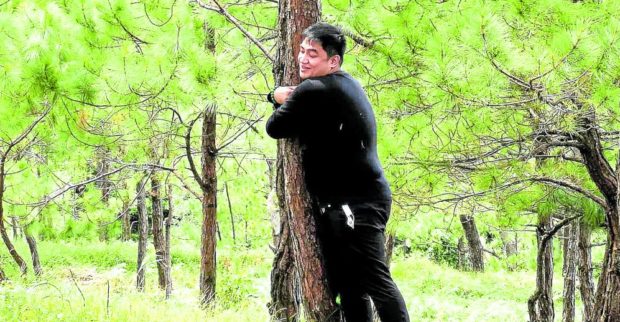
TREE HUGGER The Baguio government has begun the process of regenerating and expanding its pine tree population, which includes this forest patch at the Baguio Dairy Farm, a favorite hiking site for locals, such as this resident in this photo taken in October 2021. —EV ESPIRITU
BAGUIO CITY—The city government has started addressing the spread of “invasive plant species” in its environment as it starts regenerating the city’s depleted pine tree cover, Mayor Benjamin Magalong said on Monday.
The move came after experts noted that a number of trees growing in the city, including hardwood species and even ornamental plants and flowers adorning its parks, are water guzzlers that could affect the spread of pine trees as well as other endemic plant and animal species.
The city is currently prioritizing the preservation of its remaining pine trees, from which Baguio has earned its moniker the “City of Pines,” given that of its 2.5 million trees, only around half a million are of the Benguet Pine species.
Experts tapped
Magalong said the city’s environment and parks management office has tapped experts to manage current and future pine trees, which they hoped to grow into new forests, such as treating infected trees lining the manmade lake of Burnham Park with the help of a tree-surgery firm called JSA Inc.
Last week, scholars drew attention to ornamental or foreign plants and trees growing in city parks and other green zones.
“Some of these exotic plants can be a threat to the water security [of its fellow plants]. Ang iba, matakaw sa tubig (Some species consume more water), instead of helping conserve rainwater,” said Dr. Zenaida Baoanan, a biology professor of the University of the Philippines (UP) Baguio, who participated in an online lecture series on Sept. 9 to commemorate Baguio’s 113th foundation day.
She noted, for example, the “very dry” areas where the Mahogany and Alnus trees, species that were introduced to Baguio, are found.
Replacements
“We need to replace potential invasive plants with native plants that regulate the water cycle,” Baoanan said.
A UP team was also exploring the impact the common African tulip, which is found in many of the city’s parks, has on the Baguio ecosystem, she added.
Baoanan stressed that Baguio needs to grow back its forest cover so it can again span 40 percent of its 57-square-kilometer territory.
She said policymakers should premise the pine tree regeneration program on Baguio’s vulnerability to geological hazards. Prone to landslides, pine tree roots ideally hold together the soil along the mountain city’s slopes.
Magalong said this was part of the reason why Balete growing at the center of downtown Session Road would soon be relocated to the Botanical Gardens.
“Balete roots spread out and do not go deep enough to keep the soil stable,” he said.